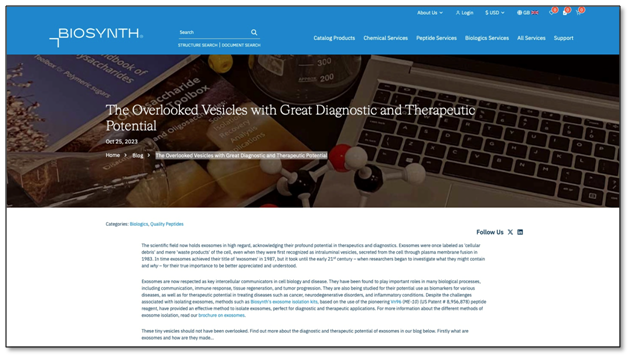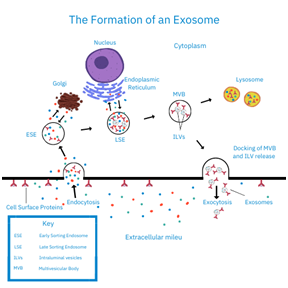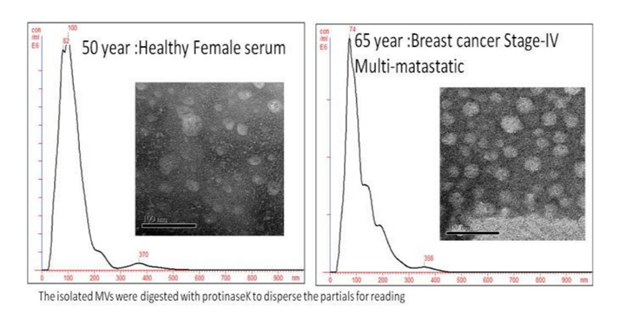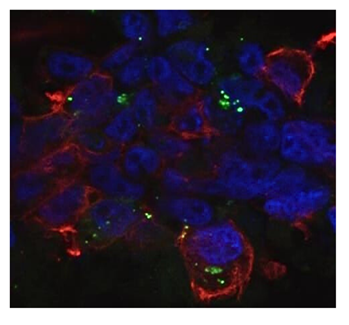By Biosynth
Biosynth highlights ‘overlooked’ therapeutic exosomes
Staad, Switzerland: – The latest blog from microbiology and organic fine biochemical specialist manufacturer and developer Biosynth AG says there are several EV extracellular vesicles or exosomes whose therapeutic value has not yet been fully recognized.
The posting ‘The Overlooked Vesicles with Great Diagnostic and Therapeutic Potential’ highlights how the life sciences that once regarded EVs as ‘cellular debris’ and mere ‘waste products’ of the cell, now holds exosomes in high regard, acknowledging their profound potential in therapeutics and diagnostics as key intercellular communicators in cell biology and disease that play important roles in many biological processes, including communication, immune response, tissue regeneration, and tumor progression.
“These tiny vesicles should not have been overlooked,” says the article, which goes on to emphasize how developing technology for isolating exosomes is uncovering an expanding range of EVs that have significant potential as diagnostic biomarkers and for therapeutic applications.
What are exosomes?
The blog provides a guide to the basic nature of exosomes as one of the two types of extracellular vesicles (EVs) secreted by the cells of prokaryotes and eukaryotes when an intermediate compartment (sometimes referred to as a multivesicular body or MVB) fuses with the plasma membrane. Ranging in size from 30 to 160 nanometers in diameter, exosomes contain a wide assortment of biomolecules, including proteins, lipids, DNA, miRNA, and mRNA supporting their primary function in intercellular communication by transferring their contents from the originating cell to other cells, both nearby and distant.
“Crucially, this transfer of information can affect the function and behavior of any recipient cells,” the blog notes.
Exosomes and Diagnostics
The blog then expands on exosomes diagnostic applications. Since they are present in a variety of biological fluids, are released from all cells, and contain important information regarding the state of their parent cells, they offer themselves as perfect candidates for non-invasive liquid biopsies to monitor diseases, including cancer, central nervous and cardiovascular conditions, and ailments of the liver, lung and kidney. Isolated exosomes have also proved useful tool in a variety of assay format.
“We have only begun to scratch the surface of the potential for this type of application,” the blog declares, showing how exosomes carrying specific oncogenic and tumor suppressor miRNAs could offer insight into cancer prognosis because the expression of these miRNAs differs between normal and cancerous cells.
It also points out that evidence is emerging that extracellular vesicles like exosomes may contribute to neurodegenerative disease progression due to their role in transporting pathogenic protein aggregates between cells.
Therapeutic Applications
The blog also takes a tour through some of the more recent therapeutic applications for exosomes, particularly as ‘courier’ vectors in delivering drug molecules or other therapeutic agents.
Instances highlighted include:
- Exosomes derived from fibroblasts, mesenchymal and dendritic cells can initiate immunomodulation and neoantigen presentation, or the delivery of a drug to targets such as immune, cancer, or parenchymal cells.
- Specific miRNA or small interfering RNA (siRNA) used as payload molecules for the purpose of suppressing gene expression, for example use of dendritic cells modified with RVG (rabies virus glycoprotein) (FR110131) and Bace1-targeting siRNA as inhibitors of BACE1 expression in the brain.
Biosynth supports vital research into the use of exosomes as diagnostic and therapeutic tools and has developed why we have available two innovative exosome isolation kits that use the peptides reagent, Vn96, which binds to canonical HSPs found on the surface of exosomes. Binding of the peptide to exosomes produces a ‘snowball effect’ that allows easy precipitation into a pellet after spinning in a standard bench top centrifuge at 10,000g. The pellet is then suitable for use in many assays such as mass spectrometry, staining, blotting, PCR, EM and more.
About Biosynth
Biosynth is a supplier of critical materials, securing life science supply chains with global research, manufacturing, and distribution facilities. Supplying the pharmaceutical and diagnostic sectors; where Chemistry meets Biology, Products meet Services and Innovation meets Quality, Biosynth is at the Edge of Innovation.
With an unrivaled research product portfolio of over a million products and end-to-end manufacturing services, Biosynth’s expertise and capability spans Complex Chemicals, Peptides, and Key Biologics, all from one trusted partner. Headquartered in Staad, Switzerland, Biosynth is owned amongst others by KKR, Ampersand Capital Partners, and management.
Find out more about Biosynth at www.biosynth.com
Resources
Click The Overlooked Vesicles with Great Diagnostic and Therapeutic Potential to read the full article.
Click on Biosynth Exosomes to access brochure.
Click on as Biosynth’s exosome isolation kits to learn more.





















